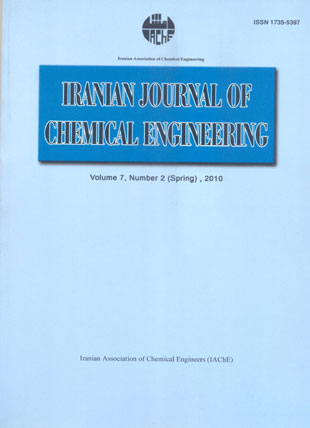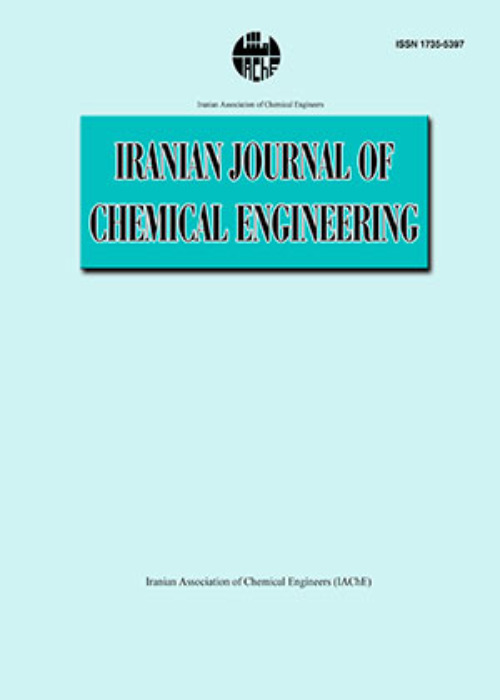فهرست مطالب

Iranian journal of chemical engineering
Volume:7 Issue: 2, Spring 2010
- تاریخ انتشار: 1389/03/01
- تعداد عناوین: 8
-
-
Page 3Catalytic combustion of lean premixed mixtures of biogas/air and biogas/hydrogen/air on Pt in a packed bed reactor has been investigated using detailed surface chemistry. Non-equilibrium, adiabatic and one dimensional flow assumptions have been adopted for simulation of the reactor. The interaction between two phases of porous medium is incorporated into the model via heat and mass transfer factors. Radiation heat transfer has been taken into account using effective thermal conductivity. All thermo-physical properties of the gas phase are considered to be temperature and concentration dependent. Two energy equations for two phases of the porous medium along with species transport equations are solved in the model. A mechanism of multi-step surface reactions, suitable for oxidation of lean mixture of methane/air, has been adopted from literature and employed for simulations. This mechanism includes 36 single step reactions with 11 surface and 6 gas phase species. Simulations have been conducted for oxidation of different biogas/air mixtures for the inlet temperature range of 700K to 900K at atmospheric pressure. The effect of the addition of hydrogen to the biogas/air mixtures has also been investigated. It is shown that hydrogen improves oxidation of methane.
-
Page 17Contrary to sandstone reservoirs, carbonate reservoirs have an oil-wetting nature. Water flooding of these fractured reservoirs with low permeability matrix blocks is not recommended unless a wettability alteration process is possible. Imbibition is an oil recovery mechanism for these types of reservoirs, if the rock matrix is water wet and there is enough water in fractures in contact with the matrix. Heavy matrix oil, high interfacial tension (IFT), oil-wet matrix sample, and limited contact area of matrix with water in fractures, requires additional effort to enhance the oil recovery by capillary imbibition. Surfactants can be injected into naturally fractured reservoirs to improve the capillary imbibition recovery performance. A well-known surfactant is Hexadecyl Trimethyl Ammonium Bromide (C16TAB), which is an appropriate type of surfactant for these kinds of reservoirs. However, due to its high cost, it is rarely used in the real case studies.In the present paper a simple and inexpensive method has been proposed for synthesizing this surfactant. Surfactant at different concentrations have been dissolved in high salinity brine, and the interfacial tension (IFT) between the aqueous solution and the oil has been measured by pendent drop method. In addition, the contact angle between the oil and the aqueous solution is measured by sessile drop method, and during the experiment, photos were taken every two seconds in order to analyse the IFT and the contact angle obtained. It has been found that reduction of IFT continues up to critical micelle concentration of the surfactant. Furthermore, a correlation has been obtained to predict the IFT between the oil and the high salinity aqueous solution containing different surfactant concentrations. Finally, the best surfactant concentration is obtained for reservoir case studies.
-
Page 28Plants and/or plant food wastes have been given much less attention or even disregarded. In some instances, however, oxidative enzymes from residual plant tissues have been shown to effectively degrade recalcitrant pollutants. Soybean seed coat peroxidase (SBP) is an inexpensive oxidoreductive enzyme and could be potentially used to oxidize/polymerize various organic pollutants of the industrial and petrochemical wastes. The catalytic properties of SBP are retained under a wide range of pH and at elevated temperatures. In the present study, the biocatalytic properties of SBP were estimated. The enzyme exhibited the highest activity and stability at pH 6.0 and retained over 75% of the maximum activity for 12 hours. The activity of SBP was found to be 2.5 times higher at an elevated temperature of 65°C compared to the activity at room temperature. The activity is retained over 95% for 30 min at 75°C. The pH and temperature of the reaction mixture showed significant influence on SBP activity. SBP is fairly active in organic solvents and exhibited the optimal activity in the presence of 20% (v/v) acetone. Increasing the organic solvent content resulted in a reduction in SBP activity.
-
Page 39Hydrocracking is an important secondary process in the petroleum industry, generally used to process heavy oil cuts. The process is tailored to various needs of refineries in order to maximize middle distillates, gasoline, LPG and similar products. Therefore, kinetic modeling of hydrocracking reactors applied to upgrade vacuum heavy oil (Isomax) is important and needs to be investigated. In this work, following a brief comparison of continuous lumping model in contrast to discrete lumping model, the former was chosen to model an operational Isomax reactor in Tabriz refinery, located in the North West of Iran. In order to categorise various unknown components True Boiling Point (TBP) of the mixtures were employed as the key parameter. Hence, the hydrocracking rate constant was assumed to be an even function of true boiling point. This would facilitate reformulation of mass-balance equations in terms of rate constant as a continuous variable. In order to determine the fraction yield distribution of the species, a specific distribution function was formulated. The resulting model equations were solved numerically and the yield of various fractions as a function of reactor residence time were estimated. A comparison between model predictions and experimental data shows it can predict the weight percent of light and heavy fractions well with an acceptable accuracy.
-
Page 51The extent of side reactions in propane dehydrogenation over Pt-Sn/Al2O3 catalyst was studied. Catalytic test runs were carried out in a fixed-bed quartz reactor under different operating conditions. The results showed that the extent of side reactions strongly depends on the operating conditions. The product distribution implied that single C-C bond rupture in propane is the predominant route for break-down of propane to the lower hydrocarbons. A beneficial effect of coke formation on propylene selectivity was observed at the expense of propane conversion, which can be attributed to the dilution effect of carbonaceous deposits on platinum sites.
-
Page 58The catalytic reduction of barite in the presence of sodium carbonate has been investigated to evaluate the effect of catalyst amount on reaction mechanism. Different amounts of sodium carbonate ranging from 2.5-10.0 wt.% were doped on coke and the test samples containing stoichiometric mixes of barite and coke powders were isothermally heated in air atmosphere. The catalytic effect of sodium carbonate was studied by isothermal experiments performed at different temperatures and reduction times. The conversion–time data were analyzed by using a modified kinetic model and the influence of catalyst content on kinetic parameters was evaluated. The results show that the addition of 7.5 wt.% sodium carbonate significantly decreases activation energy. Finally, the article concludes that catalyst amount has a negligible role on gasification of coke if the reduction process is carried out at high temperature close to 1100C. The obtained results can be useful in industrial practice.
-
Page 68Solid transport phenomena drastically affect rotary drying process. A change in any solid movement variable such as particle hold up or input flow rate results in a significant variation of heat and mass transfer rates. Therefore, in this research dynamic study of these phenomena was conducted both experimentally and theoretically. Several experiments was performed employing an industrial granule dryer. The dryer length and diameter were 5 and 1 m, respectively. In each experiment one of the solid movement variables was changed and the resulting dynamic change on the process was measured. The data was used to estimate the parameters of a dynamic distributed parameter model of the system using dynamic optimization method. The data were also employed to evaluate the model. The model predictions for solid hold up and outlet flow rate were compared with those of the experimental data. The average model error for solid hold up and outlet flow rate were 5.6% and 5.4 %, respectively.
-
Page 78


